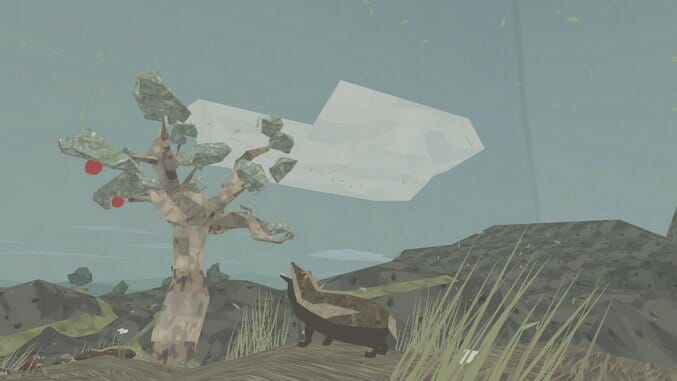
Shelter looks like a storybook. Everything is chunky, and textures are deliberately repeated. Or maybe it looks like a digital version of diorama built of papier mache and wrapping paper.
It’s a game about a mother, so let’s talk for a minute about fathers.
About three years ago a few high-profile games about fatherhood were released. The protagonists of most of Red Dead Redemption and Bioshock 2 were fathers trying to be reunited with their families. There was a physical distance between father and child. They each say something about children—a son replaces his father, and a daughter becomes a woman whose personality is influenced, but not controlled by, her father.
Three years and a game development cycle later we got The Last of Us and Bioshock Infinite (the latter made by the studio that did the original Bioshock, but not Bioshock 2), games both built around playing as an older, very capable, very violent man who is responsible for the safety of a daughter-figure. These daughters accompany their “fathers” through most of the game. Though the father-figure is ostensibly their protector, they can’t be harmed during in-game combat.
See, because if they could, then the player’s progress could be hindered by something out of their control (the AI playing these young women), and that would get in the way of the Great Protector Role that these women add to the Great White Father power fantasy. The protagonists of those games are cowboys at the end of civilization, avatars of a violence apparently necessary for the saving of the children.
In Shelter, you’re a mother badger leading her cubs on a trek through the forest. The cubs aren’t invulnerable: They get hungry and must be fed. They can be attacked by predators or washed away by rivers or burned by fire: They must be protected not just in the narrative layer of the game, but in the play built on top of that as well.
These cubs are an extension of their mother: They follow where she goes, they stop where she stops. They don’t act on their own except at night when they might be startled by a breaking twig. Then, they run a short distance away as a group and wait for her to find them.
There’s no on-screen display that shows you where the cubs are, though, so you use the mouse to move the camera and check and see if they’re still there. This is especially important when avoiding a timed-hazard like river waves or a circling hawk. Holding shift lets you run, which is useful for catching food or knocking food off of trees or chasing away foxes that want to make your cubs their food, but those cubs can’t keep up. So if you dash to safety you’ll want to spin the camera around and it will be briefly tense until you’re sure they’re all safe.
If they don’t make it, you’ll lose one of the cubs and (as far as I can tell) the hazard of that area will go away. So, though the game never tells you this, you could in theory make certain areas much easier by sacrificing one of your cubs early on. But what kind of a mother would do that?
The core weirdness at the center of this game is by no means limited to it: The idea that motherhood is defined by a woman’s sacrifice of her self for the sake of her children. Since the characters are badgers it naturalizes the notion, sending it right on down to the middle of the food chain. And as a link in the chain of videogames about parenting it throws into contrast the verbs (the actions you can do in a game—the term is used to sidestep the fact that it’s all just pressing buttons) available for videogame mothers versus videogame fathers.
The fathers of The Last of Us and Bioshock Infinite don’t have to feed their kids, don’t have to hide them, and they definitely don’t have to hide with them. But it’s more than that: They can’t. Their fatherhood is violent, it is outward-facing. It acts outside the family. It can run and it can shoot and it can kill.
Shelter’s motherhood is about providing for and protecting your children. You can kill frogs and rodents, dig up roots and knock apples off of trees, but it’s all to feed the cubs. When it comes to protecting, well, it’s largely a passive act: running and hiding. Even scaring off the foxes seems to be more a result of being larger than them and barking. This motherhood is not about affecting the outside world, except to directly benefit your children.
And yet.
There are no numbers, no easily quantifiable signals of success or failure (as the cubs get hungry, the color drains out of them and they slowly turn gray). It’s hard to tell sometimes if they’re ok, if they’re hidden, if they’re safe. I’m not a parent, but I imagine that uncertainty is a big part of it. In Shelter, though, if you know how to pay attention the system still begins to reveal itself, and while it’s never as explicit as the invulnerability of things you can’t control, you get the sense that design ideas of “fairness” mean that the lack of clear feedback from onscreen displays means that the danger is far, far less than you might imagine.
Shelter was developed and published by Might and Delight. It is available for PC and Mac.
Brian Taylor; has no children.
